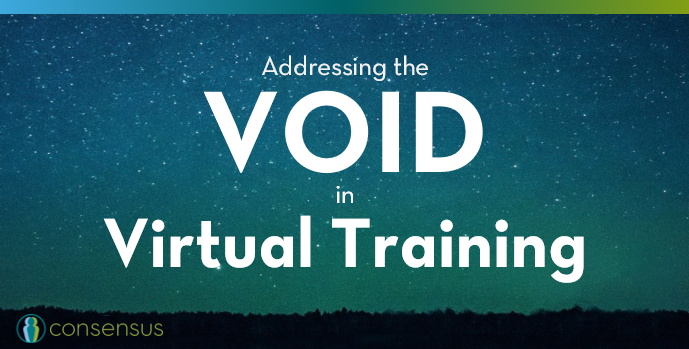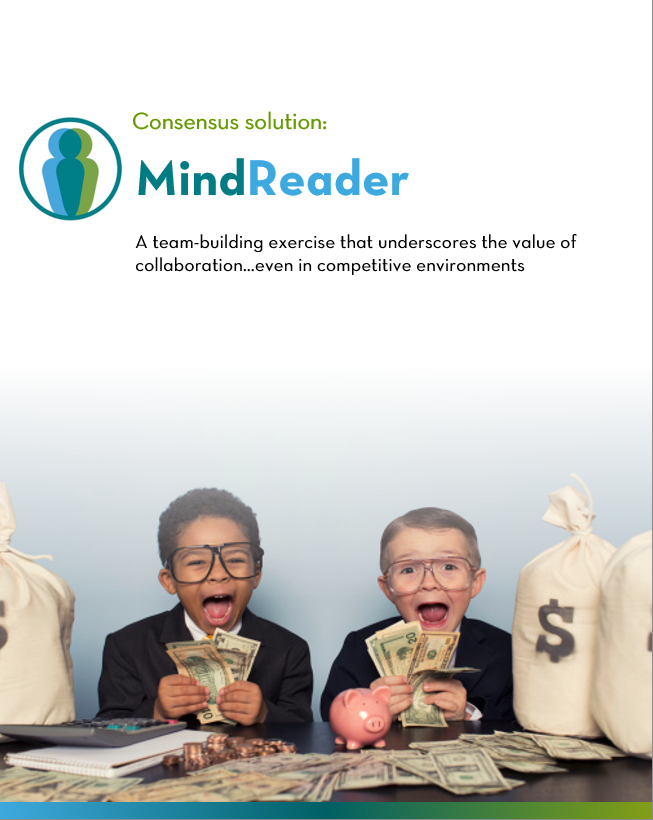Addressing the Void in Virtual Training

Addressing the Void in Virtual Training
Just as organizations are defining return-to-work plans that were to begin as early as Labor Day, society is now confronting the Delta Variant and the very real possibility that we might have to continue to rely on virtual training. And, there is widespread void in virtual training that is grossly unaddressed.
To be sure, Zoom and other cloud-based platforms haven proven to be incredibly valuable resources throughout the last eighteen months, including for training. They have enabled organizations to provide just-in-time learning, and many have found that the virtual classroom can even be effective for traditional learning including professional development, leadership training, milestone programs, DE&I initiatives, and High Potentials programs. For example, throughout Covid, our firm, Consensus (consensusgroup.com), has been delivering workshops on a variety of essential skills such as Negotiation, Influence, and Tackling Difficult Conversations to name a few, as well as timely skills such as Leading Virtual Teams, Change Leadership, and, most recently, Discussing Return-to-Work Policies.
But, what at first glance might have appeared to be a proverbial silver bullet is, at best, silver-plated: as in many realms impacted by Covid, while virtual tools have helped immensely, something critical is lacking. The consensus among our clients – which span numerous industries, and are based throughout the Americas, Europe, and Asia – is that virtual training lacks the “X Factor” inherent to the classroom: “social-networking” – a synthesis of professional networking and forging personal relationships with colleagues.
Addressing the Void in Virtual Training:
The Value of Social-Networking
Social-networking provides at least three valuable benefits to the organization.
First, research shows that when an employee has as few as a single close friendship at work, their engagement, satisfaction, and productivity increase. Moreover, their rate of attrition decreases. And, the more positive relationships one has at work, the more profound these effects are (up to a point). While enjoying a shared training experience with colleagues helps fuel these relationships, the inherent limitations imposed by curricula and the virtual training environment itself limit the opportunities for social interaction. In a live classroom, the conversations that take place while waiting for the training to begin, during coffee breaks, and even upon exiting the workshop provide the opportunities for those valuable connections to be forged.
Second, social-networking leads to a more holistic understanding of one’s organization (commonly referred to “organizational awareness” in emotional intelligence). This understanding leads to better problem solving on a macro level, with solutions that consider challenges and goals that transcend a single group or department and that factor the relationships among different parts of the organization. In addition to the higher levels of engagement and productivity associated with understanding and a sense of belonging, it also can lead to increased retention – if an employee isn’t satisfied in their current role, they have the insights and connections to move within the organization rather than defaulting to external opportunities.
Third, in the context of training, social-networking leads to a better contextualization and grounding for the concepts learned in the classroom. Participants discuss their questions and take-aways, including how models and tools apply to their work. Our facilitators find that participants often pose clarifying questions and provocative insights when returning from breaks, commonly introduced with the phrase, “Another participant and I were just discussing the following during the break…”
Organizations understand the value of the social-networking “X Factor” quite well. In normal times, they invest their budget in offsite training events in which workshops and lectures are complemented by non-training opportunities for social-networking. Some organizations have even built offsite training facilities, equipped with eateries, bars, and other places for their staff to network. Larger venues have the additional benefit of allowing participants in one program to network with colleagues attending other, concurrent trainings.
Addressing the Void in Virtual Training:
The Problem
Unfortunately, few organizations have figured out how to capture this “X Factor” value through virtual platforms. Early attempts to do so included virtual coffee hours and the like; but, they didn’t have much staying power, presumably because they may have felt overly programmed or inauthentic. Some of our clients have tried more novel activities (e.g., using avatars instead of an actual video capture of oneself) to differentiate the user experience from the endless battery of virtual meetings that their professionals face daily. Unfortunately, those clients tell us that they haven’t seen the uptake or results they had hoped for.
Whether variants of Coronavirus necessitate a solution to this conundrum or whether the corporate community demands a solution in order to enjoy the cost-savings and other benefits associated with virtual learning, it’s important that the Training community explore different possibilities in pursuit of an answer.
Addressing the Void in Virtual Training:
The Solution
Our organization (Consensus) has identified at least one solution that seems to be meeting the need: a proprietary interactive exercise called MindReader. We’ve delivered it to hundreds of participants over the past months, and thousands more over the years. MindReader brings X-Factor “coffee break energy” and social-networking into the virtual classroom.
In analyzing the experiences of our participants, we have identified seven factors that, together, make MindReader an effective solution for social-networking in a virtual environment:
1. Team Driven
MindReader is implemented in small teams (3-5 participants per team). We find that small groups, over a 60-minute span, and with members pursuing a shared objective (such as profit maximization or “winning”), a team dynamic – with genuine social bonds – evolves.
2. Multi-Dimensional
Our 60-minute exercise is composed of multiple phases and unforeseen “curveballs”. The duration, multilayers, and complexities require robust interactivity within teams and between teams. This offers much better social-networking than short, one-dimensional activities.
3. Fun
In pursuit of the goals teams set for themselves, participants’ competitive nature usually ignites. This leads to consistent engagement, spirited discussions, and plenty of laughter as teams plot against their counterparts.
4. Interactive (beyond the Team)
MindReader requires the interaction to extend beyond one’s team. Each team also interacts with their counterpart team throughout the game. And, when the game is debriefed in plenary (composed of numerous teams), a facilitated discussion broadens the interactions to include even more colleagues. Fun and laughter – as well as practical and actionable take-aways – are critical characteristics of the debrief, as well.
5. Revealing
Unlike traditional participant introductions that often are incorporated as an “icebreaker” at the outset of a training, MindReader incorporates participant introductions in small groups as part of the debrief. Our approach requires participants to be introspective before sharing meaningful information about themselves; they discuss how facets of their job, prior experiences, personal life, etc., affected their strategies, decisions, and behaviors throughout the exercise. Sharing meaning information in the small group setting, coupled with a guided conversation about that information (that relates it to the exercise), is a springboard for social-networking, both during and after the session.
6. Immersive
MindReader is driven by a propriety technology that participants access via their devices. So, while they confer via video, they simultaneously access a sophisticated software that is not limited by the functionality of videoconferencing platforms. That, combined with the introduction of unforeseen changes throughout the game, make for a more engaging experience and more opportunities for social-networking.
7. Relatable & Actionable
Virtual coffee hours have the potential to create bonds among colleagues. But, often the take-aways from those types of experiences – as well as other “team building” efforts being used in the virtual environment – have limited obvious applications in participants’ daily professional lives. In a virtual environment, we find that combining
(i) Fun and
(ii) Actionable Tools that can immediately improve participants’ professional success as soon as they leave the session
leaves participants feeling that the time they invested was not only enjoyable, but also worthwhile.
Do you have similar experiences? We very much would like to know what your organization is doing to fill this void. Please be sure to use the link below to leave your comments (on the LinkedIn posting) or, even better, Contact Us at your convenience.
Also, if You would like to learn more about how our MindReader exercise (which underscores the value of collaboration, even in competitive environments) might help your organization, we would love to connect with you.
Please feel free to contact us at any time!

We invite you to learn more about our
MindReader Leadership Skills & Team-Building Solution
Please choose the option that is most convenient for you:
• Call us at +1 (212) 391-8100
• Email us at inquiry@consensusgroup.com
• Use our Online Form and we will contact you
